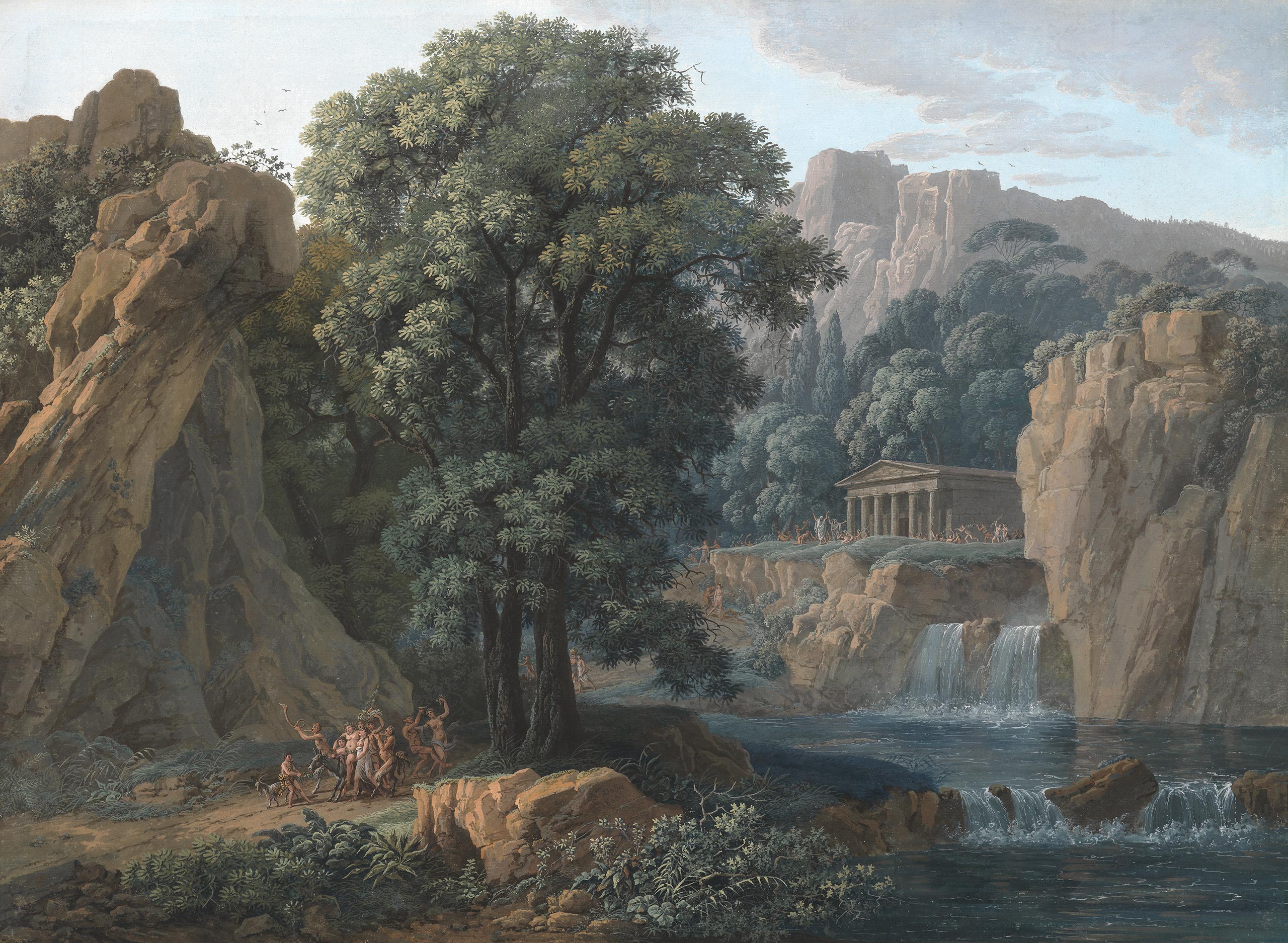
Bacler d’Albe
Louis Albert Guislain
Saint-Pol-sur-Ternoise 1761 — Sèvres 1824
Silenus’ Procession in a Classical Landscape
Pencil and gouache.
Framing lines with black gouache on the outlines.
Signed and dated Ber D’albe / 1803 on the rock on the center.
510 x 690 mm (20 1⁄16 x 27 3⁄16 in.)
Before embarking on the military career that would make him famous, Bacler d’Albe worked as a clerk for his father, the postmaster in Amiens, before choosing to follow his artistic vocation. Between 1785 and 1793, he settled in Sallanches, near the Mont-Blanc, a region that was just beginning to experience tourism, including the mountaineers Jacques Balmat and Michel Gabriel Paccard. His views of the region’s spectacular natural sites met with great success. He lived there with his young partner, whom he did not marry until 1808, and their five children.
In 1793, he enlisted to defend Republic. He distinguished himself as an officer and geographer-draughtsman at the sieges of Lyon and Toulon, where he may have met Bonaparte, then captain of artillery. Assigned to the Army of Italy (1794-1797), he held the position of official geographer and cartographer, and the accuracy of his drawings of machines and plans brought him to Bonaparte’s attention. Bonaparte commissioned him to map the coast from Nice to Savona, and to popularize his victories in paintings and drawings, which marked the start of a long career in the emperor’s service. Several of his battle scenes are preserved in the Château de Versailles museum (Louvre deposits), including the great Battle of Arcole, November 17, 1796 (INV 2397), Napoleon visiting the French army’s bivouacs on the eve of the Battle of Austerlitz, December 1, 1805 (INV 2399) and Battle of Rivoli, January 14, 1797 (INV 2398). He created the Carte du Théâtre des campagnes de Bonaparte en Italie, the first complete map of the whole of Italy (1797-1802).
In 1799, he once again entered Bonaparte’s service, first as chief engineer of the Dépôt de la Guerre (the military mapping and archive office created by Louvois), then as head of the Emperor’s topographical office. Along with Marshal Berthier, he belonged to the Emperor’s inner circle, accompanying him everywhere in peacetime and on campaign. During the campaigns: “he slept in his tent with his equipment and prepared the maps he had colored himself, marked the positions of the army corps with colored pins, calculated distances with a compass, figured the relief of the terrain for the Emperor’s maneuver plans, advised on the means of attack…”. He provided the emperor with the topographical insight needed to make strategic decisions, plan troop marches, calculate fire, etc. Promoted to colonel in 1807, brigadier general in 1813, he was made a baron d’empire in 1808. He produced the Carte de l’Empereur, the first homogeneous map of Europe. Director of the Dépôt de la Guerre in 1814-1815, he saved the copper plates of the Cassini map from looting. Despite his heavy responsibilities as a cartographer, Bacler d’Albe remained a very active painter, particularly of battles and landscapes, a genre to which he brought his topographical precision. During the Restoration, he retired to Sèvres, where he lived as a lithographer and draughtsman.
In 1803, the year in which he produced this spectacular work in terms of size and quality of execution, Bacler d’Albe was chief engineer at the Dépôt de la Guerre in Paris. Nevertheless, he was a regular exhibitor at the Salon at the beginning of the century, showing what were known as “gouache paintings”, i.e. large-scale gouaches intended to be luxuriously framed and placed on walls, and particularly landscapes of Italy or the Alps and battles. Monumental and vibrant, the landscape in our gouache is completely neo-classical in graphic technique and subject: the depiction of vegetation is precise and meticulous, and the landscape hosts a scene from Antiquity, conforming with the historical landscape tradition promoted by the Académie. Nevertheless, the artist’s sense of a grandiose, quivering and sensitive nature is almost romantic, recalling the works he produced in his youth, when he lived in Sallanches. As for the choice of scene depicted – Silenus’ procession and, further up, a crowd in full bacchanal around the temple – it shows that the painter is not attached to serious, scholarly ancient history, but to a whimsical vision of Dionysian antiquity.

